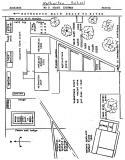Ohinemuri Regional History Journal 29, October 1985
PROGRESS DESTROYS UNIQUE RECORD OF HISTORY
By C. W. MALCOLM
We strive to preserve historical landmarks. The march of progress often destroys them. Our task then is to place them on record.
THE NETHERTON SCHOOL was officially described in the 1940s as "a model country school embodying a unique record of its own history." Since 1966 considerable development has taken place necessitating the disappearance of most of what previously existed. Past pupils visiting the school find its once unique historical features gone.
In 1966 the main block shown in the accompanying photo was cut into sections, sold for a song, and transported from the site. No longer could the pupils, by moving from classroom to classroom, "walk through history." The centre classroom had been the entire original school built on the site in 1901 at a cost of £194 (pounds). Its vertical weatherboards indicated an early era of architecture and were a testimony to the durability of the timber and the workmanship of its builders.
The west room, was an extension added in 1917 to accommodate the growing population and cost £249 (pounds). The east room, added in 1921 at a cost of £709 (pounds) was a distinctly more modern, airy, and roomy extension marking progress in school architecture. The rising costs provided a lesson in inflation.
A further historical feature was the "shelter sheds", one for the boys, the other for the girls, made good use of at Netherton long after they ceased to be provided as a valuable adjunct to schools.
The arrival of the district water supply scheme in 1940 was marked by the disappearance of the corrugated tanks fed by rain from the school roof and the erection of a swimming pool, one of the first to be built for a school. A reminder of the days of the rain-water tanks was the remaining tank high on the pump house on the edge of the large fresh water drain that flowed past the school. Pumped from the stream by an electric motor, the water, certainly not recommended for drinking, was fed by gravity to the toilets and to the tap for watering the gardens. While it remained, its elevated tank recalled the era when the school depended on its tank supply alone.
And mention of the gardens reminds one of yet another historical chapter in educational development. The agriculture plots or experimental vegetable gardens that were once a prominent feature of every school were prominently situated in the layout of Netherton. The boys took a special pride in them and in the shed of shining garden tools supplied by the Education Board. Even as early as 1947 when the writer was an acting inspector of schools few, if any, of such gardens were to be found. They had become a page of education history, Netherton School being one of the last to maintain such a valuable learning asset.
In 1940 a large bitumen sealed area completed the surroundings of the school, replacing a weedy wasteland and providing ample space for games and physical activities. The area was designed to fit round a majestic plane tree under which a lawn was put down and a valuable lesson in the preservation of the environment was given when, in 1941, the Auckland Education Board's architect, Mr A.B. Miller (his name should be remembered), in erecting the very modern open-air infant block, re-sited it rather than cut down that one tree!
Alas! in spite of local protest, a later authority, in siting the new classroom block in 1966, necessitated the destruction of the school's most picturesque environmental feature. Majestic oaks and plane trees once graced the broad shady lawn that ran along the school's frontage to the edge of the wide, deep drain that separated it from the main highway so that it became, more romantically than a mere "drain", to quote Shakespeare, "a moat defensive to a house." Through the great trees the passer-by viewed the school in its silvan setting often with its pupils lunching in the leafy shade on a summer's day.
One is reminded of Oliver Goldsmith's lines on the village schoolmaster: "the spot where many a time he triumphed, is forgot." Even the substantial residence erected in 1910 at a cost of £425 for the handy accommodation of a succession of notable head teachers, is gone. With its veranda, its large, high-ceilinged airy rooms, and its open fire-places for roaring winter fires, it was a comfortable home. It has been replaced, further back on the section where the apple orchard once flourished, by a smaller modern type of residence.
Progress has been necessary and it has been remarkable indeed as a visit to Netherton will show. Where it has inevitably removed the traces of history I substitute this record for posterity.



